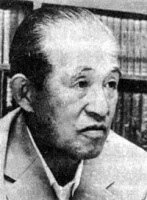| Township: | 北海道旭川市 | ||||
Read works of Yasushi Inoue at 小说之家 | |||||
Inoue is famous for his serious historical fiction of ancient Japan and the Asian continent, including Wind and Waves, Tun-huang, and Confucius, but his work also included semi-autobiographical novels and short fiction of great humor, pathos, and wisdom like Shirobamba and Asunaro Monogatari, which depicted the setting of the author's own life--Japan of the early to mid twentieth century--in revealing perspective.
Inoue, who is one of Japan's most prolific writers today, started relatively late as a novelist. He was forty-two when he published in 1949 his first works, the two novelettes Ryoju and The Bullfight, which the following year won for him the top literary prize in Japan, the Akutagawa Prize. His longer Tiles of the Tempyo Era deals both with art and ancient China; Lou-Lan and The Flood are short historical novels of China. Whether he is writing full novels, novelettes, or short-stories, however, Inoue's penchant for detailed, exhaustive research and historical accuracy give his stories a flavor of authenticity. Even the characters in his stories can often be traced back to historical individuals. In the spring of 1964, Inoue went to the United States to start his research on what he personally believes will be his magnum opus, a multi-volume treatment of first, second, and third generation Japanese abroad, particularly in the United States.
—Leon Picon, from the introduction to The Counterfeiter, published in 1965
Prizes
* 1950 Akutagawa Prize ---Togyu,闘牛
* 1957 Ministry of Education Prize for Literature ---Tiles of the Tempyo Era
* 1959 Mainichi Press Prize ---Tunhuang
* 1963 Yomiuri Prize --- Fūtō
Works
* The Bullfight, 闘牛
* The Hunting Gun, 猟銃
* Tiles of the Tempyo Era
* Tunhuang
* Shirobamba
* The Samurai Banner of Furin Kazan, 風林火山
* Lou-Lan and Other Stories
* Wind and Waves
* Journey Beyond Samarkand
* Blue Wolf: A Novel of the Life of Chinggis Khan
* The Counterfeiter and Other Stories
* Chronicle of My Mother
* Confucius
